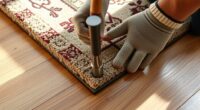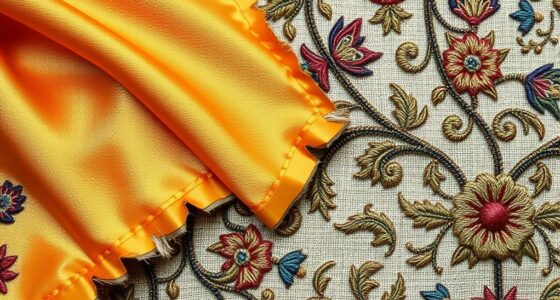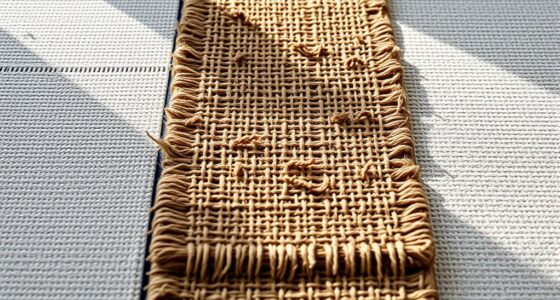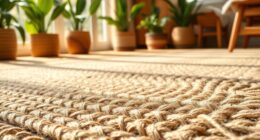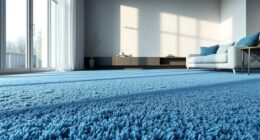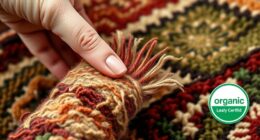Brick weave features a staggered, linear pattern with rectangular strips layered in a brick-like layout, creating a resilient and smooth surface suitable for decorative and load-bearing walls. Cross weave uses perpendicular interlacing of strips, forming a stable, open structure with intersecting lines that offer more tension control and strength, especially under heavy stress. These structural differences influence flexibility, aesthetic appeal, and application choices—exploring further reveals how each pattern impacts overall durability and visual effect.
Key Takeaways
- Brick weave features a staggered, layered pattern, providing enhanced flexibility and load distribution, while cross weave has perpendicular interlacing for stability.
- Cross weave’s over-under crossing at intersections creates a more rigid, stable structure compared to the more flexible, staggered brick weave pattern.
- Brick weave offers a uniform surface with layered texture, whereas cross weave emphasizes precise, intersecting threads for a more open, grid-like structure.
- Cross weave is typically stronger under heavy loads due to its intersecting pattern, while brick weave’s staggered design emphasizes aesthetic and moderate strength.
- The structural differences influence their applications: brick weave suits decorative, load-bearing walls; cross weave is ideal for stability in structural and artistic uses.
Basic Construction of Brick Weave
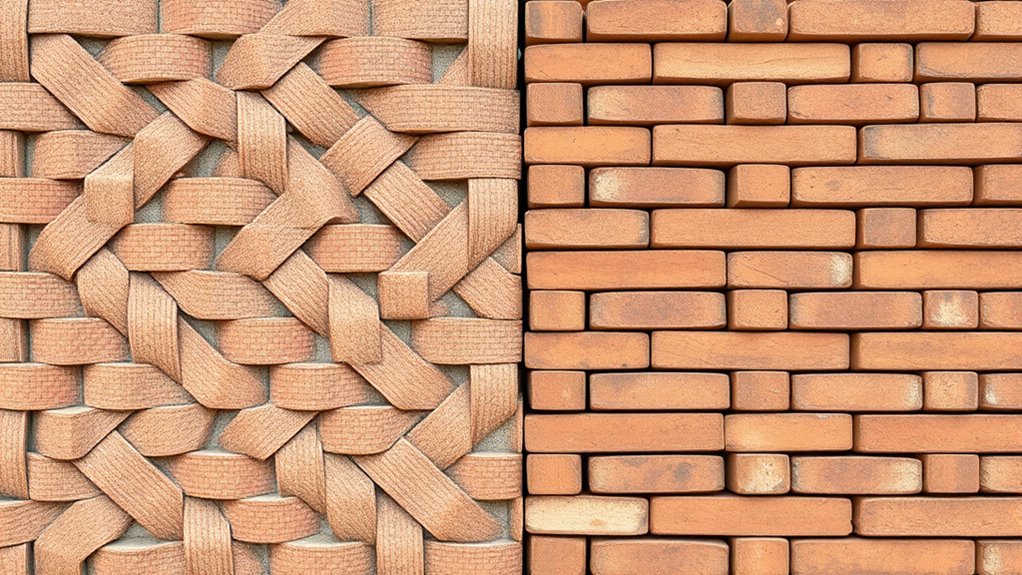
The basic construction of brick weave involves stacking rectangular strips in a staggered pattern, creating a strong and flexible fabric. You place each strip horizontally, then layer the next row offset by half a strip’s width. This pattern resembles brickwork, hence the name. The alternating placement of strips distributes tension evenly across the fabric, enhancing durability. When you weave the strips over and under each other, it forms a sturdy grid that resists tearing and stretching. This method allows the fabric to bend without losing its shape. You can adjust the tightness of the weave by varying the spacing between strips, which influences flexibility and strength. Overall, the brick weave’s straightforward, staggered design offers a resilient structure suitable for various applications. Additionally, understanding the structural differences between weaves can help in selecting the appropriate technique for specific needs.
Basic Construction of Cross Weave
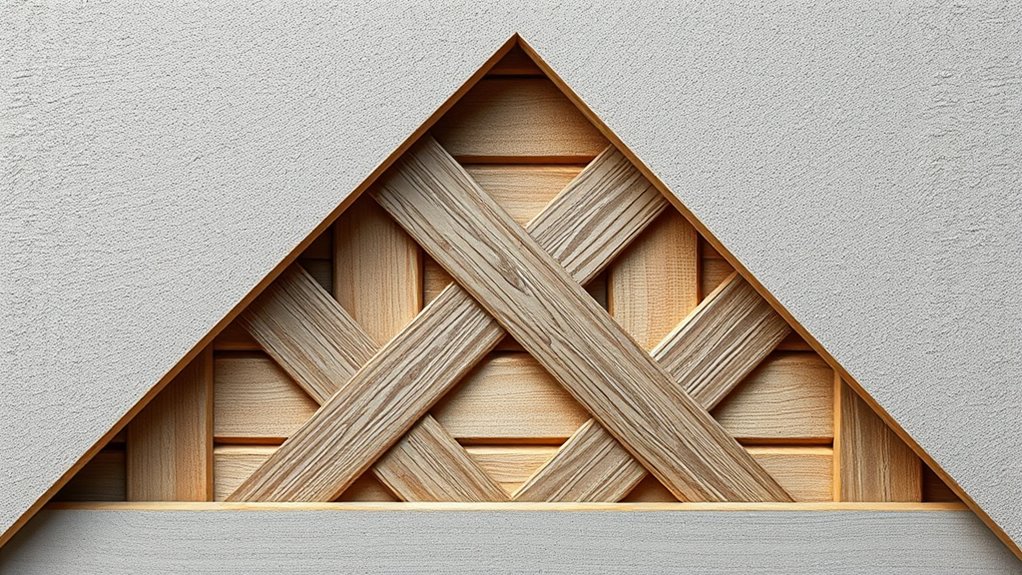
Constructing a cross weave involves interlacing strips in a perpendicular pattern, creating a grid-like fabric. You start by laying down horizontal strips, then weave vertical strips over and under them, forming intersections. This method results in a stable, open structure with clear intersections. The process emphasizes uniform tension and precise placement to guarantee consistency. The fabric’s strength and appearance depend on how tightly you weave the strips and how evenly they cross. Here’s a simple visual to help you understand the basic construction:
| Row | Step 1 | Step 2 | Step 3 |
|---|---|---|---|
| 1 | Lay horizontal strip | Weave vertical strip over | Secure intersection |
| 2 | Lay horizontal strip | Weave vertical strip under | Secure intersection |
| 3 | Repeat pattern | Repeat pattern | Repeat pattern |
| 4 | Maintain tension | Cross strips at right angles | Continue pattern |
| 5 | Complete grid | Ensure even intersections | Finalize fabric |
Additionally, maintaining proper tension during the weaving process helps ensure the structural integrity of the fabric.
Interlacing Pattern and Thread Placement

When working with a cross weave, paying attention to the interlacing pattern and thread placement guarantees a strong, uniform fabric. You should focus on how the weft and warp threads cross at right angles, creating stability. Proper thread placement ensures consistent tension and aligns threads correctly, preventing weak spots. The pattern involves interlacing each weft thread over one warp, then under the next, maintaining an even rhythm. Misaligned threads can cause uneven fabric and reduce durability. To deepen your understanding, consider these key points:
Consistent thread placement and patterning ensure fabric strength and durability.
- Precise weft and warp intersections enhance strength.
- Consistent tension prevents fabric distortion.
- Uniform patterning maintains aesthetic appeal.
- Correct thread placement influences overall fabric integrity.
Additionally, understanding the role of automation in business intelligence can help improve manufacturing processes and ensure quality control in weaving.
Structural Flexibility and Strength

You’ll notice that load distribution efficiency affects how well each weave handles stress, with some designs spreading force more evenly than others. Material compatibility variations also play a role, as different fibers or threads respond uniquely to tension. Understanding these factors helps you choose the right weave for both flexibility and strength in your project. For example, selecting fibers with appropriate material properties can enhance durability and performance.
Load Distribution Efficiency
Understanding how each weave pattern distributes loads is essential for evaluating their structural flexibility and strength. Load distribution efficiency impacts how well a weave can handle stress without compromising integrity. A more effective load spread reduces the risk of weak points and failure.
Consider these key aspects:
- Uniform load transfer minimizes stress concentrations.
- Interlocking patterns enhance stability under pressure.
- Flexibility in load paths allows movement without damage.
- Distribution strategies determine the overall durability of the structure.
Both brick and cross weaves have unique load-sharing mechanisms. Recognizing how they allocate forces helps you choose the right pattern for your project, ensuring ideal strength and flexibility for lasting performance.
Material Compatibility Variations
Material compatibility considerably influences the structural flexibility and strength of brick and cross weaves. When selecting materials, you need to consider how well they bond and interact under stress. For example, brick weaves typically use clay or concrete, which offer good compressive strength but limited tensile flexibility. Cross weaves often incorporate different materials like steel or reinforcement meshes, enhancing their ability to withstand tension and bending forces. If materials aren’t compatible, the structure can develop cracks or weaken over time, reducing durability. You should assess factors like thermal expansion, moisture absorption, and adhesion properties. Proper material compatibility ensures that the weave maintains its integrity under load, providing necessary flexibility without sacrificing strength or longevity. This careful selection directly impacts the overall performance of the structure. Additionally, understanding the material interactions involved can help prevent issues like delamination or corrosion, further extending the lifespan of the weave.
Visual Texture and Aesthetic Effects

You’ll notice how pattern complexity and depth create different visual impressions, with brick weave offering a more layered look and cross weave providing a flatter surface. The way the patterns align and establish rhythm influences the overall aesthetic, catching the eye in distinct ways. Surface uniformity and texture also play a role, affecting how light interacts with the weave and enhancing the visual appeal. Additionally, understanding the structural differences helps in selecting the appropriate weave pattern for specific design goals.
Pattern Complexity and Depth
The visual texture and aesthetic appeal of brick and cross weaves stem largely from their pattern complexity and depth. You’ll notice that brick weaves create a layered, staggered appearance, adding richness and visual interest. Cross weaves, on the other hand, feature intersecting lines that generate a more intricate, woven effect. To understand their impact better, consider these points: 1. Complexity enhances visual engagement and perceived craftsmanship. 2. Depth provides a sense of dimensionality, making surfaces appear more tactile. 3. Pattern variation influences the overall style, from traditional to modern. 4. The interplay of shapes and lines affects the emotional tone of the design. Additionally, pattern variation can significantly alter the overall aesthetic, influencing how viewers perceive the design’s style and sophistication.
Visual Alignment and Rhythm
Both brick and cross weaves shape their distinctive visual textures through careful alignment of patterns and rhythmic repetition. In brick weaving, the staggered arrangement creates a linear rhythm that guides the eye smoothly across the surface, producing a sense of stability and order. Cross weaving, however, employs intersecting lines that form a more dynamic, woven pattern, generating visual movement and complexity. Your perception of the weave’s aesthetic depends on how these alignments and repetitions are executed; consistent spacing enhances harmony, while irregularities introduce visual interest. The rhythm in brick weave feels steady and predictable, emphasizing uniformity. Conversely, cross weave’s rhythm is more varied, adding energy and vibrancy. Recognizing these differences helps you appreciate how each technique crafts its unique visual impact. The choice of weave can also influence the overall structural strength, affecting durability and aesthetic appeal.
Surface Uniformity and Texture
Surface uniformity and texture substantially influence how brick and cross weaves are perceived visually. They determine the overall aesthetic and tactile appeal of the woven material. Brick weaves tend to have a more consistent surface, creating a smooth, orderly appearance that exudes uniformity. Cross weaves, on the other hand, often feature varied textures, adding depth and complexity. Understanding these differences enhances your appreciation of their visual impact:
- Uniform surfaces promote a clean, modern look.
- Textured patterns add visual interest and complexity.
- Smooth finishes can emphasize simplicity and neatness.
- Rough or varied textures evoke a handcrafted, rustic feel.
Common Applications and Use Cases

Brick weave and cross weave are popular choices in various applications due to their durability and distinctive appearance. You’ll find them commonly used in masonry projects, where their strength supports load-bearing walls and facades. Brick weave is ideal for decorative walls, garden pathways, or architectural accents, thanks to its orderly, uniform look. Cross weave, with its interlocking pattern, offers enhanced stability, making it suitable for retaining walls or structures exposed to heavy stress. Both weaves are also used in crafts and artistic installations, providing textured surfaces that add visual interest. In industrial settings, these patterns can reinforce concrete or composite materials. Additionally, their unique architectural significance makes them popular in restoration projects aiming to preserve historic design elements. Overall, your choice depends on whether you prioritize aesthetic appeal or structural resilience, but both serve well in applications demanding robustness and style.
Frequently Asked Questions
How Does the Weaving Technique Affect the Overall Durability of Each Weave?
You might wonder how weaving techniques impact durability. When you choose a weave, consider that the pattern affects strength; for example, a tighter weave generally offers more resilience. Brick and cross weaves each provide different levels of durability based on their structure. Brick weaves tend to be sturdy but flexible, while cross weaves often enhance strength and stability. Your choice influences how well the fabric withstands wear and tear over time.
Can Brick and Cross Weaves Be Combined in a Single Structure?
Did you know combining different weaves can enhance strength? Yes, you can integrate brick and cross weaves into a single structure. This blending allows you to leverage each weave’s benefits, like increased durability and aesthetic appeal. You just need to plan carefully, ensuring the weaves are compatible and properly aligned. By doing so, you create a more resilient and visually interesting structure that benefits from multiple weaving techniques.
What Maintenance Is Required for Each Type of Weave?
You’ll need to inspect both weaves regularly for signs of wear or damage. For brick weaves, focus on checking the mortar joints and replacing any cracked or deteriorated mortar to maintain stability. Cross weaves require tightening or replacing loose or broken strands. Clean both types periodically to remove dirt and debris that can cause deterioration. Proper maintenance guarantees your structure remains strong, durable, and visually appealing over time.
Are There Specific Environmental Conditions That Favor One Weave Over the Other?
You should consider environmental conditions when choosing a weave type. If you face high humidity or frequent rainfall, a cross weave might be better because it offers better water resistance and durability. On the other hand, brick weave is more suitable for dry, stable environments since it provides superior stability and aesthetic appeal. Assess your climate to determine which weave will perform best in your specific conditions.
How Do the Manufacturing Processes Differ for Each Weaving Style?
Imagine the manufacturing process as a high-stakes race—you need precision and speed. For brick weave, you typically set up the loom to interlock yarns in a staggered pattern, requiring careful tension control. Cross weave involves crossing yarns at right angles, demanding different tension and alignment techniques. Each style uses unique techniques and machinery, making their production processes distinct, much like choosing between a sleek sports car and a rugged off-road vehicle.
Conclusion
Now that you understand the differences between brick weave and cross weave, it’s clear that each has its own strengths and unique appeal. You’ll find that choosing the right one depends on your specific needs, whether you prioritize strength, flexibility, or aesthetic. Remember, it’s often the subtle details that make all the difference—so don’t judge a book by its cover. With this knowledge, you’re better equipped to make an informed decision and get the most out of your project.

